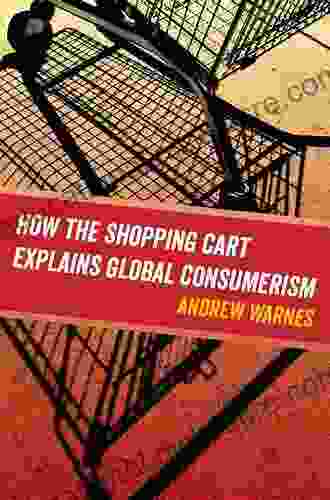How the Shopping Cart Explains Global Consumerism: A Comprehensive Analysis of the Symbol and Its Impact


The shopping cart, a ubiquitous fixture in retail stores worldwide, is a profound symbol of global consumerism. Its simple yet effective design has revolutionized the way we shop, facilitating a consumption-driven society that has shaped our economies, societies, and environments. This article delves into the intricate relationship between the shopping cart and global consumerism, examining its historical origins, cultural significance, and far-reaching implications.
4.4 out of 5
| Language | : | English |
| Text-to-Speech | : | Enabled |
| Enhanced typesetting | : | Enabled |
| Word Wise | : | Enabled |
| Lending | : | Enabled |
| File size | : | 4013 KB |
| Print length | : | 176 pages |
| Screen Reader | : | Supported |
The History of the Shopping Cart
The concept of a mobile shopping container emerged in the early 20th century with the invention of the "carry basket" in 1936 by Sylvan Goldman in Oklahoma City. This basket, made of lightweight aluminum, was designed to be carried by hand and was an instant hit. In 1937, Orla Watson of California developed the first "shopping cart" that could be pushed or pulled by customers. This innovation gained widespread popularity, and by the 1950s, shopping carts had become an indispensable part of the retail landscape.
The Convenience Factor: Empowering Consumers
The shopping cart's primary function is to provide convenience to consumers. By allowing shoppers to carry multiple items simultaneously, it reduces the strain of carrying bags or baskets, making the shopping experience more pleasurable. This convenience factor has contributed significantly to the growth of consumerism, as it encourages shoppers to purchase more items than they might have otherwise. The cart's mobility also allows consumers to browse multiple aisles and compare products, leading to increased impulse purchases.
The Symbol of Affluence and Aspiration
In many cultures, the shopping cart has become a symbol of affluence and aspiration. Owning a car and being able to fill it with consumer goods is often seen as a sign of financial success and social status. The shopping cart, therefore, represents the promise of a consumer-driven lifestyle, where material possessions equate to happiness and fulfillment. This aspiration is particularly strong in emerging economies, where consumerism is seen as a path to modernity and economic prosperity.
The Environmental Impact: A Double-Edged Sword
While the shopping cart has revolutionized shopping, it has also raised concerns about its environmental impact. The production, distribution, and disposal of shopping carts require significant resources and contribute to waste and pollution. Additionally, the convenience of the shopping cart may encourage excessive consumption, leading to increased resource depletion and environmental degradation. However, on the positive side, shopping carts also promote reusable shopping bags, reducing plastic waste and aiding sustainability efforts.
The Social Implications: Shaping Societal Norms
The shopping cart has profoundly influenced societal norms and behaviors. It has facilitated the rise of large-scale shopping malls and supermarkets, transforming the way people socialize and interact. The shopping cart serves as a shared space where strangers engage in a common activity, creating opportunities for both connection and conflict. It can also shape shopping habits, encouraging bulk purchases and a "one-stop shop" mentality that prioritizes convenience over local businesses.
Cultural Variations: Adapting to Local Needs
Despite its global ubiquity, the shopping cart has undergone cultural adaptations to suit local needs and preferences. In some Asian countries, for example, shopping carts are typically smaller and more lightweight due to narrower aisles and smaller store sizes. In some European countries, shopping carts are often equipped with coin-operated locks to prevent theft and encourage their return after use. These variations highlight how the shopping cart has become a customizable tool that reflects the unique characteristics of different societies.
The Future of the Shopping Cart: Embracing Innovation
The shopping cart is not immune to technological advancements and evolving consumer behaviors. As e-commerce gains popularity, the traditional shopping cart may face challenges. However, the future of the shopping cart is likely to be marked by innovation and adaptation. Smart shopping carts with built-in screens, payment systems, and inventory management capabilities are already being developed. These innovations aim to enhance the shopping experience, providing personalized recommendations and reducing checkout times.
The shopping cart is a multifaceted symbol that embodies the complex relationship between global consumerism, convenience, aspiration, environmental concerns, and social norms. Its simple, yet effective design has transformed the way we shop, shaping our economies, societies, and environments. As consumerism continues to evolve, the shopping cart will likely adapt and endure, serving as a testament to the power and pervasiveness of the global consumer culture.
4.4 out of 5
| Language | : | English |
| Text-to-Speech | : | Enabled |
| Enhanced typesetting | : | Enabled |
| Word Wise | : | Enabled |
| Lending | : | Enabled |
| File size | : | 4013 KB |
| Print length | : | 176 pages |
| Screen Reader | : | Supported |
Do you want to contribute by writing guest posts on this blog?
Please contact us and send us a resume of previous articles that you have written.
 Fiction
Fiction Non Fiction
Non Fiction Romance
Romance Mystery
Mystery Thriller
Thriller SciFi
SciFi Fantasy
Fantasy Horror
Horror Biography
Biography Selfhelp
Selfhelp Business
Business History
History Classics
Classics Poetry
Poetry Childrens
Childrens Young Adult
Young Adult Educational
Educational Cooking
Cooking Travel
Travel Lifestyle
Lifestyle Spirituality
Spirituality Health
Health Fitness
Fitness Technology
Technology Science
Science Arts
Arts Crafts
Crafts DIY
DIY Gardening
Gardening Petcare
Petcare Sean Bloomfield
Sean Bloomfield J Richard Hackman
J Richard Hackman Ginger Scott
Ginger Scott Andrew Zerling
Andrew Zerling Tom Holland
Tom Holland John Macgregor
John Macgregor E K Johnston
E K Johnston Sendhil Mullainathan
Sendhil Mullainathan Melisenda Edwards
Melisenda Edwards Rob Eastaway
Rob Eastaway Michael Polanyi
Michael Polanyi Garth Nix
Garth Nix Donn F Draeger
Donn F Draeger Marie Sherlock
Marie Sherlock Tim Clarkson
Tim Clarkson Andrew Hempstead
Andrew Hempstead Kuldeep Singh
Kuldeep Singh Texes Exam Secrets Test Prep Team
Texes Exam Secrets Test Prep Team Kevin Anderson
Kevin Anderson Dawne Archer
Dawne Archer Sam Maggs
Sam Maggs Nick Jaffe
Nick Jaffe Michaela Deprince
Michaela Deprince J D Lenzen
J D Lenzen Gordon Wright
Gordon Wright Justine Bold
Justine Bold Behrouz Moemeni
Behrouz Moemeni Chris Dowhan
Chris Dowhan M L Ray
M L Ray Akil Palanisamy
Akil Palanisamy Ira J Chasnoff
Ira J Chasnoff Jon Paschetto
Jon Paschetto H A Lorentz
H A Lorentz Elijah N Daniel
Elijah N Daniel Sadie Robertson
Sadie Robertson Joy Vines
Joy Vines Daniel Mark Brown
Daniel Mark Brown Mark Needham
Mark Needham Jennie Erin Smith
Jennie Erin Smith Paul Seabright
Paul Seabright Jill Squyres Groubert Phd
Jill Squyres Groubert Phd Timothy Gordon
Timothy Gordon Teresa Palmer
Teresa Palmer Teresa M Twomey
Teresa M Twomey Christopher Vaughan
Christopher Vaughan Jeffro Johnson
Jeffro Johnson Michele Amitrani
Michele Amitrani John H Carroll
John H Carroll Marcus Tomlinson
Marcus Tomlinson Chaz Scoggins
Chaz Scoggins Andrew Phillip Smith
Andrew Phillip Smith Kay Pranis
Kay Pranis Charles Darwin
Charles Darwin David Carrasco
David Carrasco Jennifer Lw Fink Rn Bsn
Jennifer Lw Fink Rn Bsn C Todd Lombardo
C Todd Lombardo Linda Whitenton
Linda Whitenton Jordan Ellenberg
Jordan Ellenberg Henry Fielding
Henry Fielding Vivien Newman
Vivien Newman Andrew M Greeley
Andrew M Greeley John Atherton
John Atherton Jerry M Gutlon
Jerry M Gutlon Margot Kahn
Margot Kahn Peggy Orenstein
Peggy Orenstein N S Wikarski
N S Wikarski Harvey Motulsky
Harvey Motulsky Carolyn Savage
Carolyn Savage Madeleine L Engle
Madeleine L Engle Ronald T Kneusel
Ronald T Kneusel Charles Cooper
Charles Cooper Touko Amekawa
Touko Amekawa Shannon Brown
Shannon Brown Daniel Tammet
Daniel Tammet Shari Mezrah
Shari Mezrah Fatime Losonci
Fatime Losonci Walter Martin
Walter Martin Mark Vanhoenacker
Mark Vanhoenacker W Michael Kelley
W Michael Kelley Rachel Lynn Solomon
Rachel Lynn Solomon John Daido Loori
John Daido Loori Andrius Jac
Andrius Jac Rick Scoppe
Rick Scoppe John Mcphee
John Mcphee Bob Brier
Bob Brier Lisa Silverman
Lisa Silverman Master Wong
Master Wong Andrew X Pham
Andrew X Pham Mark Cannizzaro
Mark Cannizzaro Dustin Howe
Dustin Howe Winifred Gallagher
Winifred Gallagher Quick Guide
Quick Guide Laurie David
Laurie David John Helyar
John Helyar Lauren Conrad
Lauren Conrad Kirk Goldsberry
Kirk Goldsberry Kris Holloway
Kris Holloway Eddy Starr Ancinas
Eddy Starr Ancinas Kevin Shea
Kevin Shea Hp Newquist
Hp Newquist James P Sethna
James P Sethna Ernest Becker
Ernest Becker Natalie Babbitt
Natalie Babbitt Reid Sheftall M D
Reid Sheftall M D Wendy Bryden
Wendy Bryden Steve Lage
Steve Lage Davida Hartman
Davida Hartman George W Hart
George W Hart Mirabai Starr
Mirabai Starr Julie Lythcott Haims
Julie Lythcott Haims Dan Anderson
Dan Anderson Jason William
Jason William Mary H K Choi
Mary H K Choi Carson Mccullers
Carson Mccullers Ruth Haley Barton
Ruth Haley Barton Tami Fox
Tami Fox Betty Smith
Betty Smith Ehsan Masood
Ehsan Masood Xavier P Hunter
Xavier P Hunter Philip Reeve
Philip Reeve Andrew Stellman
Andrew Stellman Claire Phillips
Claire Phillips Yasuharu Okuda
Yasuharu Okuda Christopher O Shaughnessy
Christopher O Shaughnessy Jack David Eller
Jack David Eller Samara Caughey
Samara Caughey Jay Sokolovsky
Jay Sokolovsky Gina M Biegel
Gina M Biegel Stephen James
Stephen James Gordon Churchill
Gordon Churchill Andrew Moore
Andrew Moore Catherine Gildiner
Catherine Gildiner M J Abadie
M J Abadie Elizabeth Acevedo
Elizabeth Acevedo Clare Keyes
Clare Keyes Cassandra Erkens
Cassandra Erkens Monty Roberts
Monty Roberts Andrew Hudson
Andrew Hudson Richard Bullivant
Richard Bullivant Rory Stewart
Rory Stewart Vanessa A P
Vanessa A P Brian L Silver
Brian L Silver Tom Rosenbauer
Tom Rosenbauer Tony Ray
Tony Ray Michael F Roizen
Michael F Roizen Geraldine Woods
Geraldine Woods Michael Barela
Michael Barela Stephanie V W Lucianovic
Stephanie V W Lucianovic Nicholas Harvey
Nicholas Harvey Roger Highfield
Roger Highfield Tanya Crossman
Tanya Crossman Rudy Rucker
Rudy Rucker Rolf Potts
Rolf Potts Rupert Sheldrake
Rupert Sheldrake Justine Bateman
Justine Bateman Shonda Rhimes
Shonda Rhimes Julia Cameron
Julia Cameron Morten Lund
Morten Lund Rosicrucian Order Amorc
Rosicrucian Order Amorc Molly E Lee
Molly E Lee Stacey Lee
Stacey Lee Palle Yourgrau
Palle Yourgrau Daniel D Fox
Daniel D Fox George Washington Cable
George Washington Cable Des Hewitt
Des Hewitt Vincent Norman
Vincent Norman Anne Marie Scully
Anne Marie Scully Carolyn Coker Ross
Carolyn Coker Ross Nicholas D Souza
Nicholas D Souza Sally Bjornsen
Sally Bjornsen Sian Beilock
Sian Beilock Kari Kampakis
Kari Kampakis Aristeidis Bampakos
Aristeidis Bampakos Andrew Warnes
Andrew Warnes Mary Sheedy Kurcinka
Mary Sheedy Kurcinka Chris Mcmullen
Chris Mcmullen Rhianna Pratchett
Rhianna Pratchett Michael J Thompson
Michael J Thompson Glenn Berkenkamp
Glenn Berkenkamp Fiona Higgins
Fiona Higgins Michelle Madow
Michelle Madow Rolf Dobelli
Rolf Dobelli Tiffany Harelik
Tiffany Harelik Becky Albertalli
Becky Albertalli Mark Mcclusky
Mark Mcclusky Howard Thurman
Howard Thurman Linda Goldberg
Linda Goldberg Damon B Akins
Damon B Akins Jessica Speer
Jessica Speer Elizabeth Walter
Elizabeth Walter Kathrine Switzer
Kathrine Switzer Rami Ungar
Rami Ungar George H Odell
George H Odell Andrew Peterson
Andrew Peterson Stephen Cole
Stephen Cole Jay Arthur
Jay Arthur Omar D Lewis Sr
Omar D Lewis Sr Laird Hamilton
Laird Hamilton Joey Rive
Joey Rive Lisa Cron
Lisa Cron Thomas Clarkson
Thomas Clarkson Sharae Moore
Sharae Moore Zita Grant
Zita Grant Erika V Shearin Karres
Erika V Shearin Karres Cathy Kelly
Cathy Kelly Delphi Classics
Delphi Classics Paul Davies
Paul Davies Helen O Neil
Helen O Neil Ross Bernstein
Ross Bernstein Gabriel Weinberg
Gabriel Weinberg Stephan Lee
Stephan Lee Dr John Hockey
Dr John Hockey Pawel Guziejko
Pawel Guziejko Joya Goffney
Joya Goffney Briana Wiles
Briana Wiles Diane R Gehart
Diane R Gehart Luca Brambilla
Luca Brambilla Andy Crouch
Andy Crouch Jennifer M Rosner
Jennifer M Rosner Maggie Stiefvater
Maggie Stiefvater Robert Kurson
Robert Kurson Mawi Asgedom
Mawi Asgedom Chaim Potok
Chaim Potok Christine Carter
Christine Carter Arthur Kleinman
Arthur Kleinman Bruno David
Bruno David Nina Varela
Nina Varela Michael Epperson
Michael Epperson Stephen Rea
Stephen Rea Gordon Webster
Gordon Webster Madeleine Roux
Madeleine Roux Jenny Randles
Jenny Randles Robert Holdstock
Robert Holdstock Leigh Bernacchi
Leigh Bernacchi Adam Minter
Adam Minter Andy Burnham
Andy Burnham William J Broad
William J Broad Chris Rodell
Chris Rodell Thomas F Hornbein
Thomas F Hornbein Eric H Cline
Eric H Cline Ben Foss
Ben Foss Andy Ankowski
Andy Ankowski Tom Bertrand
Tom Bertrand Suzanne Van Atten
Suzanne Van Atten Gene Stone
Gene Stone Slow Sprint
Slow Sprint Jamie Thornton
Jamie Thornton Aaron Edkins
Aaron Edkins P Anastasia
P Anastasia Elianor M A
Elianor M A W Somerset Maugham
W Somerset Maugham Brock Lesnar
Brock Lesnar Carla Killough Mcclafferty
Carla Killough Mcclafferty Sarah Castille
Sarah Castille Shannon Van Den Berg
Shannon Van Den Berg Kathleen Huggins
Kathleen Huggins Donna Tartt
Donna Tartt Carla Hannaford
Carla Hannaford Robert M Schoch
Robert M Schoch Ashley Schmitt
Ashley Schmitt J K Rowling
J K Rowling Sadhguru
Sadhguru Patrick Felicia
Patrick Felicia Nancy Frey
Nancy Frey Peter Kaminsky
Peter Kaminsky Michio Kaku
Michio Kaku Dora Kurimay
Dora Kurimay Rachel E Spector
Rachel E Spector Kirk W Johnson
Kirk W Johnson Sebastian Deterding
Sebastian Deterding Chelsea Johnson
Chelsea Johnson Jonathan Scott
Jonathan Scott Daniel W Cunningham
Daniel W Cunningham Edgar H Schein
Edgar H Schein Samuel Hideo Yamashita
Samuel Hideo Yamashita Sharon A Hansen
Sharon A Hansen Rachel Pepper
Rachel Pepper Vibrant Publishers
Vibrant Publishers Monica Clyde
Monica Clyde Kevin Thomas
Kevin Thomas Mike Cohn
Mike Cohn Shannon Jensen
Shannon Jensen Robert Parris Moses
Robert Parris Moses David Hawkins
David Hawkins William Ma
William Ma William Gurstelle
William Gurstelle Nadia Shammas
Nadia Shammas Rosalind Miles
Rosalind Miles Sara T Gibbs
Sara T Gibbs Rainer Martens
Rainer Martens Atul K Mehra
Atul K Mehra The Car Crash Detective
The Car Crash Detective Sol Adoni
Sol Adoni Andrew Lawler
Andrew Lawler Andrew J Wakefield
Andrew J Wakefield Hugh P Mckenna
Hugh P Mckenna Ed Rosenthal
Ed Rosenthal Debbie Felkins Tamez
Debbie Felkins Tamez Prosanta Chakrabarty
Prosanta Chakrabarty Marissa Meyer
Marissa Meyer Sean B Carroll
Sean B Carroll Heidi Dais
Heidi Dais Lisa Roberts
Lisa Roberts Laird Scranton
Laird Scranton Ilene And Gary Modica
Ilene And Gary Modica Stephen Prata
Stephen Prata Lynn Painter
Lynn Painter Tina H Boogren
Tina H Boogren Bryan Sykes
Bryan Sykes Uma Dinsmore Tuli
Uma Dinsmore Tuli Annette K Larsen
Annette K Larsen Hope Jahren
Hope Jahren Claiborne Young
Claiborne Young James D Watson
James D Watson Seabury Quinn
Seabury Quinn Claire Ahn
Claire Ahn Andrew Lang
Andrew Lang Gordon W Green
Gordon W Green Marsha Walker
Marsha Walker Lauren James
Lauren James S G Taylor
S G Taylor Justin Fox Burks
Justin Fox Burks Martin Woodward
Martin Woodward Brianne Donaldson
Brianne Donaldson James R Hansen
James R Hansen Frances A Yates
Frances A Yates Luna Fox
Luna Fox Rosita Boland
Rosita Boland Timothy Ferris
Timothy Ferris Melanie Burnell
Melanie Burnell Bruce H Lipton
Bruce H Lipton Erwin Schrodinger
Erwin Schrodinger Guy Windsor
Guy Windsor Edward C Klatt
Edward C Klatt Andrew Nahum
Andrew Nahum Edmund Nequatewa
Edmund Nequatewa Judy Ford
Judy Ford Richard Twiss
Richard Twiss J P Mcevoy
J P Mcevoy Slavka Bodic
Slavka Bodic Carl Hart
Carl Hart Bill Pennington
Bill Pennington Andrew Shaw
Andrew Shaw Helene St James
Helene St James Peter D Jeans
Peter D Jeans Guns Ammo
Guns Ammo Cary Hanson
Cary Hanson Rhonda V Magee
Rhonda V Magee Antonio Pigafetta
Antonio Pigafetta Michael J Mauboussin
Michael J Mauboussin Ron Hackett
Ron Hackett Sarah Digregorio
Sarah Digregorio Jen Benson
Jen Benson Andrew Thompson
Andrew Thompson Andrew Hodges
Andrew Hodges Carolyn S Schroeder
Carolyn S Schroeder Christine Pearson Casanave
Christine Pearson Casanave Joseph Bronson
Joseph Bronson Eva Longoria
Eva Longoria Liz Prince
Liz Prince Nicholas J Higham
Nicholas J Higham Andrew Robinson
Andrew Robinson Stan Tekiela
Stan Tekiela Seth J Gillihan Phd
Seth J Gillihan Phd Gila Leiter
Gila Leiter Ruth Bell Graham
Ruth Bell Graham Dan Allan
Dan Allan Zhongxian Wu
Zhongxian Wu Marcos Romero
Marcos Romero Christopher Dunn
Christopher Dunn Antipodean Writer
Antipodean Writer Richard G Klein
Richard G Klein Stephen Howe
Stephen Howe L Kathleen Mahan
L Kathleen Mahan Mona Liza Santos
Mona Liza Santos John R Anderson
John R Anderson Jim Flynn
Jim Flynn Alexander Bennett
Alexander Bennett Lauren Kate
Lauren Kate Mallory Striesfeld Ms Lpc
Mallory Striesfeld Ms Lpc David Sowell
David Sowell Educational Brain Games
Educational Brain Games Janis Abrahms Spring
Janis Abrahms Spring Ruta Sepetys
Ruta Sepetys Ricky Roberts Iii
Ricky Roberts Iii Clinton Anderson
Clinton Anderson Christine Moore
Christine Moore John Sefton
John Sefton K A Linde
K A Linde Mike Wells
Mike Wells Tom Chesshyre
Tom Chesshyre Miles Smeeton
Miles Smeeton Jim Hardy
Jim Hardy Helene Henderson
Helene Henderson Marian Stamp Dawkins
Marian Stamp Dawkins Jakob Schwichtenberg
Jakob Schwichtenberg Mark Lester
Mark Lester Sam Fels
Sam Fels Larry Jacobson
Larry Jacobson William E Hearn
William E Hearn Xan Barksdale
Xan Barksdale Sabrina Chevannes
Sabrina Chevannes Dr Sarah Mitchell
Dr Sarah Mitchell Tim Huffman
Tim Huffman Kent Nerburn
Kent Nerburn Mark Hyman
Mark Hyman Neil Harman
Neil Harman Piero Ferrucci
Piero Ferrucci Jonathan C Slaght
Jonathan C Slaght Lisa Bevere
Lisa Bevere John Eberhart
John Eberhart Jamie Christian Desplaces
Jamie Christian Desplaces T H Lain
T H Lain Pseudo Nym
Pseudo Nym Beverly Asante Puschmann
Beverly Asante Puschmann Gary Todd
Gary Todd Gladstone Califf
Gladstone Califf Charlie Jones
Charlie Jones Emily Kerr
Emily Kerr Melody Groves
Melody Groves Dave Chambers
Dave Chambers Jim Burnett
Jim Burnett Richelle Mead
Richelle Mead David A French
David A French Christopher Hodapp
Christopher Hodapp Jared Benson
Jared Benson Emily Wibberley
Emily Wibberley David Jefferson
David Jefferson Bronwen Skye
Bronwen Skye John Lofty Wiseman
John Lofty Wiseman Leslie Klenke
Leslie Klenke Maggie Ryan
Maggie Ryan Andrew Reeves
Andrew Reeves Mark Vella
Mark Vella Jonathan Bennett
Jonathan Bennett Tom Doak
Tom Doak Connie Goldsmith
Connie Goldsmith Dawn Isaac
Dawn Isaac Nancy Wainer Cohen
Nancy Wainer Cohen Dan Werb
Dan Werb Stephon Alexander
Stephon Alexander Nigel Calder
Nigel Calder Sarah Edmondson
Sarah Edmondson Erin Macpherson
Erin Macpherson Andrew Hartman
Andrew Hartman Rita Jablonski
Rita Jablonski Angela Berkfield
Angela Berkfield K L Walther
K L Walther Damon Wiseley
Damon Wiseley Nelson L Schuman
Nelson L Schuman Dan Orr
Dan Orr Ruth E Van Reken
Ruth E Van Reken Stanley L Jaki
Stanley L Jaki Andrew Heywood
Andrew Heywood Benedict Goleman
Benedict Goleman Loris Chen
Loris Chen Jessie Cal
Jessie Cal Lawrence Dawson
Lawrence Dawson Andrew H Knoll
Andrew H Knoll Diane Tober
Diane Tober Portia Macintosh
Portia Macintosh Sue Fleming
Sue Fleming Fourth Edition Kindle Edition
Fourth Edition Kindle Edition Sarah Pinborough
Sarah Pinborough Emilie Bailey
Emilie Bailey Dennis J Stanford
Dennis J Stanford Carl Petersen
Carl Petersen Peter Compton
Peter Compton Fred Rogers
Fred Rogers Jerry Z Muller
Jerry Z Muller Judith A Cohen
Judith A Cohen Jason R Rich
Jason R Rich Nick Estes
Nick Estes Bill Dance
Bill Dance Simson L Garfinkel
Simson L Garfinkel Robert N Wiedenmann
Robert N Wiedenmann Patrick Barrett
Patrick Barrett Marianne Ryan
Marianne Ryan Jaimal Yogis
Jaimal Yogis Carl Allchin
Carl Allchin Jon Gertner
Jon Gertner William Mark Huey
William Mark Huey Anthony Bishop Lmft
Anthony Bishop Lmft Eli Maor
Eli Maor Brian Grossenbacher
Brian Grossenbacher David Stipp
David Stipp Susana Wald
Susana Wald Jerusha Clark
Jerusha Clark Christian Heath
Christian Heath Bryan Mellonie
Bryan Mellonie James Berry
James Berry Lucy Atkins
Lucy Atkins Kinley Macgregor
Kinley Macgregor Howling Moon Books
Howling Moon Books Bridgit Danner Lac
Bridgit Danner Lac Jennie Lynn Gillham
Jennie Lynn Gillham Andrew Jamieson
Andrew Jamieson V S Ramachandran
V S Ramachandran Caroline Finnerty
Caroline Finnerty Sally Cook
Sally Cook Sheryl Feinstein
Sheryl Feinstein Mikael Krief
Mikael Krief
Light bulbAdvertise smarter! Our strategic ad space ensures maximum exposure. Reserve your spot today!

 Clark CampbellMedical Mistake: The Baby We Couldn't Keep and Our Choice to Deliver the...
Clark CampbellMedical Mistake: The Baby We Couldn't Keep and Our Choice to Deliver the... Dominic SimmonsFollow ·5.9k
Dominic SimmonsFollow ·5.9k Jon ReedFollow ·9.2k
Jon ReedFollow ·9.2k Milan KunderaFollow ·5.1k
Milan KunderaFollow ·5.1k Jan MitchellFollow ·9.4k
Jan MitchellFollow ·9.4k Gus HayesFollow ·19.2k
Gus HayesFollow ·19.2k Ian McEwanFollow ·4.1k
Ian McEwanFollow ·4.1k Jerome PowellFollow ·2.9k
Jerome PowellFollow ·2.9k Houston PowellFollow ·16.2k
Houston PowellFollow ·16.2k

 Craig Blair
Craig BlairThe Story of Champion Bronc Rider Bill Smith: A Legacy of...
In the annals of rodeo...

 H.G. Wells
H.G. WellsAmazing Real Life Stories In The News
The news is often...

 Jordan Blair
Jordan Blair35 Wellness Walks to Expand Awareness, Increase Vitality,...
In an era where technology...

 Edward Reed
Edward ReedCycling London to Paris: An Epic Adventure in the Making
Are you ready for the...

 Edgar Hayes
Edgar HayesEveryday Steps For Putting Technology In Its Proper Place
Are you constantly...

 Mitch Foster
Mitch FosterSat Math Mastery Advanced Algebra Geometry And Statistics
SAT Math Mastery Advanced Algebra Geometry...
4.4 out of 5
| Language | : | English |
| Text-to-Speech | : | Enabled |
| Enhanced typesetting | : | Enabled |
| Word Wise | : | Enabled |
| Lending | : | Enabled |
| File size | : | 4013 KB |
| Print length | : | 176 pages |
| Screen Reader | : | Supported |









